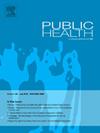预防童婚作为孕前保健战略:塞内加尔基于模型的成本效益分析
IF 3.2
3区 医学
Q1 PUBLIC, ENVIRONMENTAL & OCCUPATIONAL HEALTH
引用次数: 0
摘要
本模型研究评估了在塞内加尔实施社区敏感化干预措施以防止童婚的成本和收益。通过特别侧重于预防新生儿死亡和死产,它为这些干预措施的更广泛的健康影响提供了一个新的视角,解决了在对孕前保健战略进行经济评价方面的一个重大差距。研究设计:基于模型的经济评价。方法:我们开发了一个确定性的、基于队列的模拟模型,以估计社区宣传对塞内加尔农村防止童婚的经济和社会影响。该模型比较了现状和干预方案,以衡量三年多来干预措施对一群青春期女孩的影响。该模型的输入,包括干预成本、效应大小、流行病学和人口统计学参数,均来自二手来源。使用基于生命的统计价值方法将预防的新生儿死亡和死产货币化。结果通过干预,预计3年后童婚率下降3.4%。因此,我们估计,在这组少女中,2579例少女怀孕、86例新生儿死亡和46例死产将得到预防。收益成本比为4.2:1,即每投资1美元,净收益为3.2美元。结论:这些研究结果表明,预防童婚作为一种孕前健康策略具有巨大的经济和健康效益。该研究强调了解决孕产妇和儿童健康上游决定因素的重要性。它还强调需要进一步分析低收入和中等收入国家孕前干预措施的成本效益。本文章由计算机程序翻译,如有差异,请以英文原文为准。
Child marriage prevention as a preconception health strategy: A modelling-based cost-benefit analysis in Senegal
Objectives
This modelling study evaluates the costs and benefits of implementing community sensitisation interventions to prevent child marriage in Senegal. By focusing specifically on the prevention of neonatal mortality and stillbirths, it offers a new perspective on the broader health implications of such interventions, addressing a critical gap in the economic evaluation of preconception health strategies.
Study design
Model-based economic evaluation.
Methods
We developed a deterministic, cohort-based simulation model to estimate the economic and societal impacts of community sensitisation to prevent child marriage in rural Senegal. The model compared a status quo and an intervention scenario to measure the interventions's impact in a cohort of adolescent girls over three years. The model's inputs, including intervention costs, effect size, and epidemiological and demographic parameters, were derived from secondary sources. The neonatal deaths and stillbirths prevented were monetised using a value of a statistical life-based approach.
Results
The intervention is projected to reduce the prevalence of child marriage by 3.4 % after three years. As a result, we estimated that 2579 adolescent pregnancies, 86 neonatal deaths, and 46 stillbirths would be prevented within the cohort of adolescent girls. The benefit-cost ratio was 4.2:1, indicating a net benefit of US$3.2 for every dollar invested.
Conclusions
These findings demonstrate the substantial economic and health benefits of child marriage prevention as a preconception health strategy. The study highlights the importance of addressing upstream determinants of maternal and child health. It also underscores the need for further cost-benefit analyses of preconception interventions in low and middle-income countries.
求助全文
通过发布文献求助,成功后即可免费获取论文全文。
去求助
来源期刊

Public Health
医学-公共卫生、环境卫生与职业卫生
CiteScore
7.60
自引率
0.00%
发文量
280
审稿时长
37 days
期刊介绍:
Public Health is an international, multidisciplinary peer-reviewed journal. It publishes original papers, reviews and short reports on all aspects of the science, philosophy, and practice of public health.
 求助内容:
求助内容: 应助结果提醒方式:
应助结果提醒方式:


